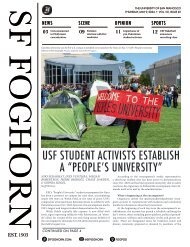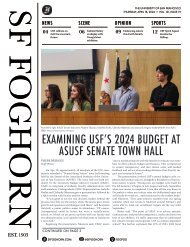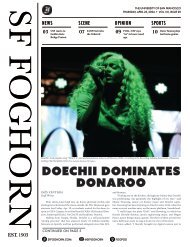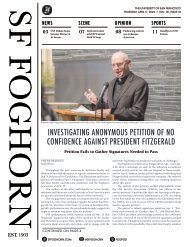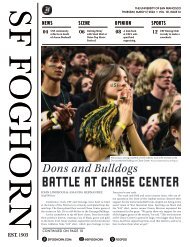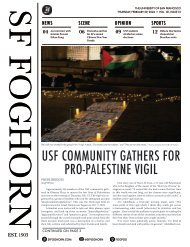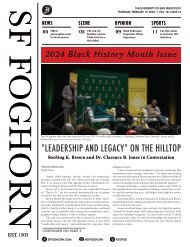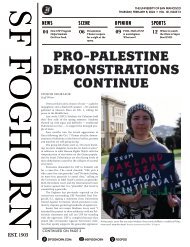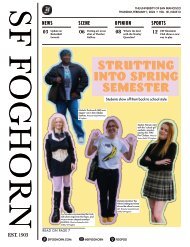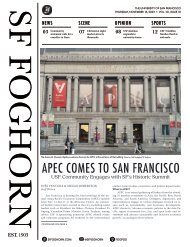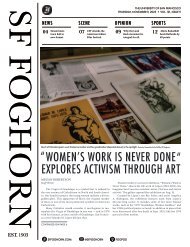VOL 120, ISSUE 16 - March 9th, 2023
Create successful ePaper yourself
Turn your PDF publications into a flip-book with our unique Google optimized e-Paper software.
02<br />
THURSDAY<br />
MAR 9,<br />
<strong>2023</strong><br />
STAFF<br />
SUBMISSION POLICY<br />
The San Francisco Foghorn is the<br />
official student newspaper of the<br />
University of San Francisco and is<br />
sponsored by the Associated Students<br />
of the University of San Francisco<br />
(ASUSF).<br />
The thoughts and opinions expressed<br />
herein are those of the individual writers<br />
and do not necessarily reflect those<br />
of the Foghorn staff, the administration,<br />
the faculty, staff or the students<br />
of the University of San Francisco.<br />
Contents of each issue are the sole<br />
responsibilities of the editors.<br />
An All-American<br />
Publication<br />
ad maiorem dei<br />
gloriam<br />
415.422.5444<br />
sffoghorn.com<br />
The San Francisco Foghorn is free of<br />
charge.<br />
Advertising matter printed herein is<br />
solely for informational purposes.<br />
Such printing is not to be construed<br />
as written or implied sponsorship<br />
or endorsement of such commercial<br />
enterprises or ventures by the San<br />
Francisco Foghorn.<br />
©MMIV-MMV, San Francisco Foghorn.<br />
All rights reserved. No material<br />
printed herein may be reproduced<br />
without prior permission of the Editor<br />
in Chief.<br />
SAN FRANCISCO<br />
FOGHORN<br />
Freedom and Fairness<br />
Editor in Chief<br />
ZOE BINDER<br />
zebinder@dons.usfca.edu<br />
News Editor<br />
NIA RATLIFF<br />
mnratliff@dons.usfca.edu<br />
Opinion Editor<br />
OLIVER RIVER SATALICH<br />
omriversatalich@dons.usfca.edu<br />
Scene Editor<br />
JORDAN PREMMER<br />
jepremmer@dons.usfca.edu<br />
Sports Editor<br />
JOHN PAOLO<br />
jnpaolo@dons.usfca.edu<br />
Photography Editor<br />
DOMINIQUE CADENAS CALVO<br />
dicadenascalvo@dons.usfca.edu<br />
General Reporter<br />
JORDAN DELFIUGO<br />
jgdelfiugo@dons.usfca.edu<br />
General Reporter<br />
SOPHIA MCCRACKIN<br />
smmccrackin@dons.usfca.edu<br />
Managing Editor<br />
NORA WARD<br />
naward2@dons.usfca.edu<br />
Copy Editor<br />
SAVANNAH DEWBERRY<br />
skdewberry@dons.usfca.edu<br />
Layout Editor<br />
AVA LORD<br />
ajlord@dons.usfca.edu<br />
Layout Editor<br />
KRISTEN JOHNSON<br />
kjohnson20@dons.usfca.edu<br />
Social Media Manager<br />
MARIA ZAIED<br />
mfzaied@dons.usfca.edu<br />
Online Editor<br />
HAYLEY DIEMAR<br />
htdiemar@dons.usfca.edu<br />
Advisor<br />
TERESA MOORE<br />
2130 FULTON STREET, UC #417<br />
SAN FRANCISCO, CA 94117<br />
Columns for the Opinion section<br />
and Letters to the Editor are gladly<br />
accepted from students, faculty, staff<br />
and alumni.<br />
All materials must be signed and<br />
include your printed name, university<br />
status (class standing or title), address,<br />
and telephone number for verification.<br />
Anonymous submissions are not<br />
published.<br />
We reserve the right to edit materials<br />
submitted. All submissions become the<br />
property of the San Francisco Foghorn.<br />
Staff editorials are written by the<br />
Foghorn editorial staff and represent a<br />
group consensus.<br />
The San Francisco Foghorn Opinion<br />
page is a forum for the free, fair and<br />
civil exchange of ideas. Contributors’<br />
opinions are not meant to reflect<br />
the views of the Foghorn staff or the<br />
University of San Francisco.<br />
Students interested in contributing to<br />
the Foghorn can scan and fill out the<br />
QR code below.<br />
STAFF EDITORIAL<br />
WOMEN IN JOURNALISM<br />
DESERVE OUR RESPECT<br />
Journalism is<br />
one of many industries<br />
that has<br />
historically excluded<br />
women,<br />
but gender diversity<br />
in newsrooms<br />
across the country<br />
is on the rise.<br />
With increased<br />
diversity in newsrooms<br />
comes increased<br />
diversity<br />
in stories, and a<br />
healthier news<br />
media overall.<br />
Newsrooms are the most gender-diverse<br />
they’ve ever been. Neiman Lab reported<br />
that in 1971, women made up only 22%<br />
of daily newspaper journalists, and 11% of<br />
television journalists. But as of 2019, according<br />
to the News Leaders Association’s<br />
diversity survey, 41.8% of all newsroom<br />
workers are women.<br />
However, non-white women continue<br />
to be underrepresented in newsrooms. In<br />
a study conducted by the American Society<br />
of News Editors across 661 newsrooms,<br />
under 3% of their journalists were Black<br />
women. Hispanic women and Asian women<br />
both made up about 2%, and Native<br />
American and Hawaiian/Pacific Islander<br />
women combined accounted for less than<br />
1%. Although white women are a minority<br />
compared to the men who dominate the<br />
industry, they are better represented than<br />
women of color.<br />
While there has been an increase in female<br />
journalists, there has not been an<br />
increase in respect. In a 2022 study from<br />
UNESCO, 73% of female journalists reported<br />
receiving online harassment, and<br />
25% received threats of physical violence.<br />
Journalists who were women of color, or<br />
LGBT identifying, experienced the highest<br />
rates and most severe of online threats.<br />
The lack of respect for female journalists<br />
is so deeply imbued into our culture that it<br />
has infiltrated popular media, which refuses<br />
to take women in journalism seriously.<br />
The clearest image some of our generation<br />
might have of what it means to be a<br />
female journalist comes from the poor caricatures<br />
that plague Hollywood. Romantic<br />
comedies like “How to Lose a Guy in Ten<br />
Days” (2003) and “Trainwreck” (2015)<br />
paint female journalists as fluffy writers<br />
with little else to do than pursue a man<br />
— who often ends up being their article’s<br />
subject. As said in the Atlantic, sleeping<br />
with sources is a tired trope that has been<br />
hashed and rehashed ten times over. This<br />
is especially egregious when real life journalists<br />
are falsely portrayed this way, as the<br />
late journalist Kathy Scruggs was in Clint<br />
Eastwood’s 2019 film “Richard Jewell.”<br />
PHOTO COURTESY OF WIKIMEDIA COMMONS<br />
It’s not that fluffy stories are inherently<br />
bad, but they’re not all that female journalists<br />
are capable of writing. Women have a<br />
long history of making strides in journalism,<br />
one that deserves a reputation beyond<br />
Hollywood tropes.<br />
Ida B. Wells-Barnett was a prominent<br />
journalist in the late 1<strong>9th</strong> century who<br />
covered and spoke out about the horrible<br />
lynchings Black Americans faced from their<br />
white counterparts. Wells, who was born<br />
into slavery, was one of the first journalists<br />
to push back against white supremacy in<br />
the press, which led to threats against her<br />
life. She was a trailblazer, not only for women<br />
but for her entire field, and was finally<br />
honored by a Pulitzer prize posthumously<br />
in 2020.<br />
In 2017, Jodi Kantor and Megan Twohey<br />
of the New York Times wrote a story that<br />
changed womens’ lives for the better. The<br />
piece, which detailed the experiences of several<br />
women who were sexually harassed by<br />
(formally successful) Hollywood producer<br />
Harvey Weinstein, sparked the #MeToo<br />
movement.<br />
Last year, Politico recapped tangible<br />
changes the #MeToo movement made for<br />
women and other vulnerable groups and<br />
other vulnerable groups. They reported<br />
that, “Between 2017 and 2021, states introduced<br />
2,324 #MeToo-related bills and<br />
passed 286,” including bills championing<br />
anti-harassment practices and pay equity.<br />
Increasing female representation in journalism<br />
means that women, who make up<br />
about half of the world’s population, can<br />
tell their stories on their own terms. Journalists<br />
cover stories that will eventually<br />
be referred to in history books, and they<br />
should reflect the nuanced identities of the<br />
cultures they represent.<br />
Although women still face challenges<br />
in journalism, trailblazers like Wells, Kantor,<br />
Twohey, and so many others have set<br />
the precedent that female journalists can<br />
do great things. As a primarily female-led<br />
publication, the Foghorn will continue to<br />
uphold the values of great female journalists<br />
before us and continue to pave the way for<br />
this change to occur.<br />
WOMEN AND THE CLIMATE JUSTICE<br />
MOVEMENT AT USF<br />
JORDAN DELFIUGO<br />
Staff Writer<br />
Women, especially women of color, have historically played an instrumental<br />
role in environmental activism. For Women’s History Month, the Foghorn is<br />
reflecting on how women at USF are forging a better future through intersectional<br />
environmental activism on campus and beyond.<br />
Since the 1970s, environmental researchers have recognized a coinciding<br />
relationship between society’s exploitation of women and its exploitation of<br />
the environment. In the United Nations’ 2030 Agenda for Sustainable Development,<br />
a 17 item plan that outlines necessary steps for a more sustainable<br />
future, gender equality is named as a “necessary foundation for a peaceful,<br />
prosperous, and sustainable world.”<br />
Media studies professor Dorothy Kidd has been involved in this movement<br />
for most of her life, first participating in youth activism and research<br />
in the 1970s. “There was this idea in the 1970s that not only did we need to<br />
be feminist to change the world, but we needed to have an understanding of<br />
changing the environment,” said Kidd.<br />
Kidd continues to advocate for environmental justice through her research<br />
on extractivism, the removal of large quantities of natural materials<br />
for export. In addition to her research, Kidd centers environmental issues and<br />
communications in her teaching.<br />
Adrienne Johnson, an environmental studies professor, also works to<br />
incorporate climate justice in her classes. “I’ve designed and taught a class<br />
on gender and the environment and I really hope students take away that<br />
environmental issues are highly political ones,” she said. “I employ an intersectional<br />
lens, meaning I hope students walk away understanding how<br />
your personal identity can shape to what extent you have access to a healthy<br />
environment or not.”<br />
Though climate change affects everyone, women are exceedingly vulnerable<br />
to the effects of environmental destruction. Damage to the environment<br />
puts women at an increased susceptibility to health ailments, such as malaria<br />
and the Zika virus, which are linked to miscarriages and anemia in women.<br />
Women are also spatially and socially affected by climate change. The<br />
UN estimates that 80% of people displaced as a result of environmental destruction<br />
are women. Additionally, a 2020 study published by the British<br />
Medical Journal found that natural disasters increase the rate of gender-based<br />
violence for women and girls. Johnson’s current research centers around missing<br />
and murdered Indigenous women and girls and the oil extraction industry.<br />
On campus, female students are also actively working to promote climate<br />
justice. Hiveminders is a woman-led and BIPOC run environmental<br />
student group that practices beekeeping on campus. Hiveminders President<br />
and fourth-year environmental studies major Miya Stephanoff described the<br />
Last semester’s Nature Immersion class at Point Reyes National Seashore. PHOTO COURTESY OF SARAH WHITWAM<br />
club as a “safe space for queer BIPOC students.”<br />
Stephanoff said that mindfulness plays a central role in the club’s operations.<br />
“It is simply a joyous and wholesome time, which is something necessary<br />
but not often found,” she said. “Our club focuses on making those<br />
joyous moments happen which is its own form of climate activism.”<br />
Current research suggests that the practice of mindfulness can serve as<br />
a form of environmental activism. According to the American Psychological<br />
Association, the practice can help facilitate a stronger connection to the environment<br />
and subsequently promote more sustainable behaviors.<br />
Another woman and non-binary led student organization on campus<br />
is BIPOC for the Environment. The club was started at USF in 2018 after<br />
its founder, USF class of 2020 alumna Darla Mariduena, identified a lack of<br />
diversity in USF’s environmental departments. The club works to expand the<br />
presence of people of color in the environmental programs on campus, as well<br />
as in the movement as a whole.<br />
“It’s important to be educated and involved in order to salvage our communities<br />
and our homes,” said Beatrice Johnson-Drysdale, third-year engineering<br />
major and the club’s director of operations. “Women have a nurturing<br />
and empathetic gift that we need more of in environmental activism if we<br />
want to make our earth a more sustainable place.”<br />
Other environmental clubs at USF, like the Environmental Engineering<br />
and Science Club, and Strategies for Ecology Education, Diversity, and Sustainability<br />
(SEEDS), are also led by women.<br />
Outside of campus clubs, students like Rachel Struer, a fourth-year environmental<br />
studies major, are highly involved in environmental activism.<br />
Struer works in the Office of Sustainability and previously worked as a teaching<br />
assistant for nature immersion, a class that promotes deepening people’s<br />
connection to nature through class trips in Northern California.<br />
The class is taught by environmental studies professor Kim Carfore, who<br />
specializes in the relationship between women and the environment. “[Carfore]<br />
focuses a lot of her work and in our class on slowing down and pulling<br />
ourselves out of all the little distractions and different tugs that our modern,<br />
technological, capitalist world teases us with,” Struer said. “[We] just back<br />
into ourselves and then out into the real, tangible, beautiful world.”<br />
Stephanoff also expressed admiration for Carfore and the female faculty<br />
in the environmental studies department. “Novella Carpenter and Kim<br />
Carfore are two professors who have inspired me to live with climate justice<br />
close to my heart,” she said. “They encouraged me to find and listen to my<br />
intuition which has already led me to connect with so many powerful women<br />
on campus who all care so deeply for the environment.”<br />
The empathetic influence of women in environmental activism is something<br />
Struer said she admires. “[Women] focus on the fact that this place is<br />
our home and we are all connected together,” she said. “It’s empathy that will<br />
move us forward.”<br />
03<br />
NEWS




